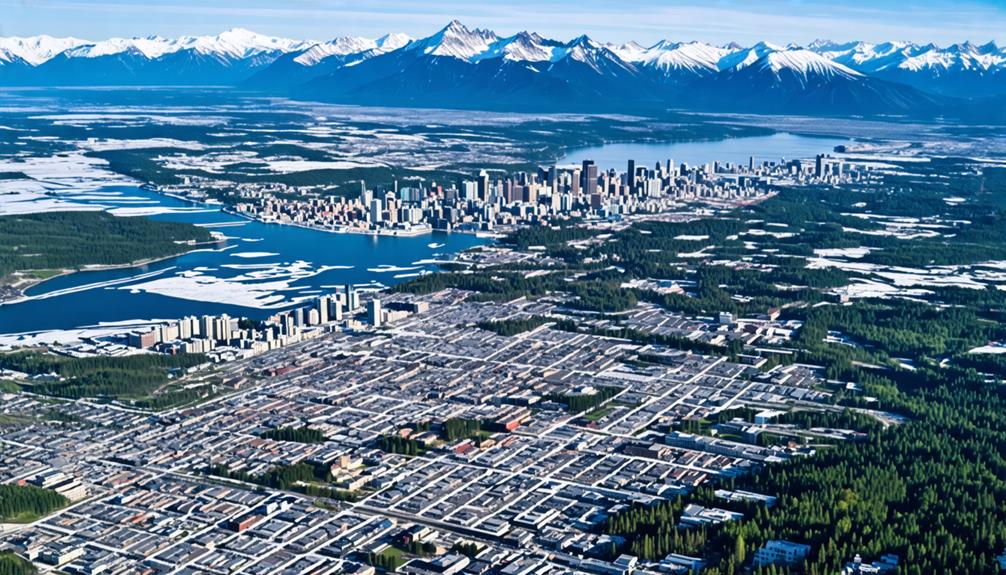You've probably heard the striking statistic that 90% of Canadians live within 100 miles of the U.S. border, but have you ever wondered why? This concentrated population distribution isn't just a quirk of geography—it's the result of complex economic, climatic, and historical factors. As you consider this phenomenon, you'll uncover fascinating insights about Canada's development, its relationship with its southern neighbor, and the challenges of inhabiting one of the world's largest countries. The reasons behind this demographic trend are more intriguing and far-reaching than you might initially think.
Key Takeaways
- Approximately 90% of Canada's population resides within 100 miles of the U.S.-Canada border.
- Southern regions of Canada offer milder climates and more fertile land, attracting higher population density.
- Major urban centers like Toronto and Montreal are located near the U.S. border.
- Economic opportunities and trade relationships with the U.S. encourage settlement close to the border.
Geographic Distribution of Canadians

When you look at a map of Canada's population, you'll notice a striking pattern: the vast majority of Canadians live clustered along the southern border with the United States. This geographic distribution isn't random; it's shaped by various factors.
Approximately 90% of Canadians reside within 100 miles of the U.S.-Canada border, with over 72% living below the 49th parallel. The southern regions offer more favorable conditions, including milder climate and fertile land, which have attracted settlement over time.
Major urban centers like Toronto and Montreal are situated just south of the 49th parallel, contributing to the high population density near the border. Climate factors play a vital role, as harsher conditions in northern Canada discourage settlement.
This concentration of Canadians in the south reflects a complex interplay of geography, climate, and historical development patterns.
Economic Factors Driving Border Proximity
Three key economic factors drive Canadians to live near the U.S. border: robust trade relationships, enhanced job opportunities, and access to larger markets.
You'll find that economic activity in Canada is heavily concentrated in these areas, with a significant portion of the population living within 100 miles of the U.S. border. The proximity to the U.S. fosters strong trade relationships and employment opportunities, making these regions more economically viable for Canadians.
Free trade agreements like USMCA further incentivize border living by facilitating easier access to markets and resources. Urban centers near the border, such as Toronto and Montreal, offer a wealth of economic prospects that attract individuals and families.
Additionally, the strong networks in these areas promote economic collaboration and cultural exchanges, reinforcing the trend of Canadians settling close to the U.S. border.
Climate and Urban Concentration

Canada's unique climate patterns play an essential role in shaping the country's urban landscape and population distribution.
You'll find that most Canadians live in southern regions, where milder temperatures foster urbanization and create more opportunities. Cities like Toronto and Montreal benefit from less harsh winters, making them attractive to residents.
Climate considerations notably influence where Canadians choose to live. Here's why approximately 90% of the population resides within 100 miles of the US border:
- More temperate climate in southern areas
- Severe cold deters settlement in northern Canada
- Greater economic and urban amenities near the border
The concentration of Canadians near the US border is a direct result of these climate factors.
However, future climate changes may alter this pattern, potentially making northern regions more habitable and shifting population dynamics across the country.
Conclusion
You've learned that Canada's population clusters near the U.S. border for good reason.
It's where you'll find the best jobs, milder weather, and bustling cities.
The southern region's fertile land and strong trade ties with the U.S. make it an attractive place to settle.
While the vast northern wilderness remains sparsely populated, you're likely to encounter most Canadians within that 100-mile border zone, reaping the benefits of this strategic location.

Leave a Reply